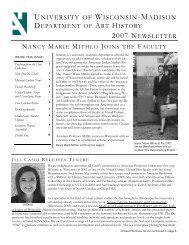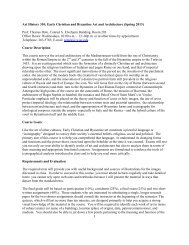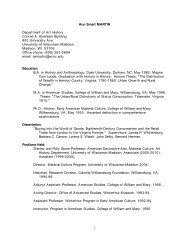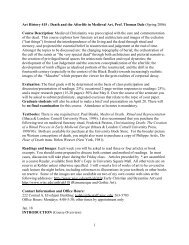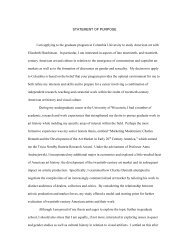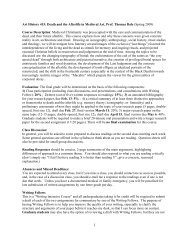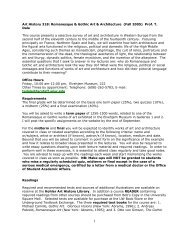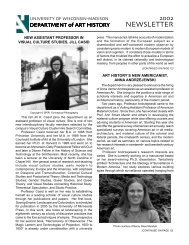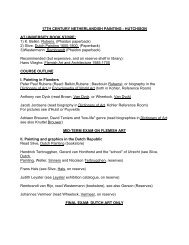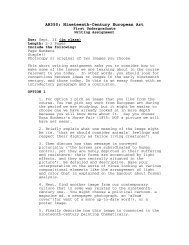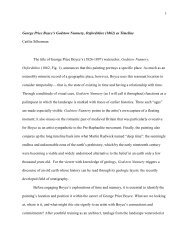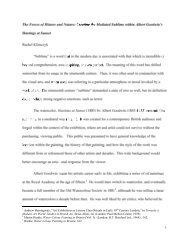University of Wisconsin-Madison Department of Art History
University of Wisconsin-Madison Department of Art History
University of Wisconsin-Madison Department of Art History
You also want an ePaper? Increase the reach of your titles
YUMPU automatically turns print PDFs into web optimized ePapers that Google loves.
PAGE 8<br />
PAGE 5<br />
Milwaukee Exhibition showcases dialogue<br />
between old and new media<br />
An exhibition co-curated by <strong>Art</strong> <strong>History</strong> alumna, Martha Monroe<br />
(B.A. ’03; M.A. ’06) and Ph.D. candidate Amy L. Powell<br />
(M.A. ’07), New Media at the Charles Allis, begins with a question:<br />
what is new about new media? Installed throughout the<br />
historic rooms <strong>of</strong> the Charles Allis <strong>Art</strong> Museum in Milwaukee<br />
where Monroe is curator, the works employ a range <strong>of</strong> artistic<br />
strategies to interrogate the interplay between "new" and "old"<br />
media, challenging assumptions that new media are entirely new<br />
or that certain technologies are dead, their problems no longer<br />
relevant to twenty-first century audiences.<br />
Pr<strong>of</strong>essor Jill Casid (UW <strong>Art</strong> <strong>History</strong>), exhibits a series <strong>of</strong> her<br />
own works, Intimographies, that use an iPhone application titled<br />
"Shake It" to recreate the visual effects <strong>of</strong> SX-70 Polaroid photographs<br />
for iPod Touch. The scale and display <strong>of</strong> her images in<br />
handmade wooden boxes lined with velvet interiors recall a much<br />
older form <strong>of</strong> photography: the nineteenth-century Daguerreotype<br />
that circulated in small, unique boxes designed to be held in the<br />
hand. BA Harrington (M.A. ’10) constructed the boxes in the<br />
installation. James Barany <strong>of</strong> the Milwaukee Institute <strong>of</strong> <strong>Art</strong> &<br />
Design uses nineteenth-century audio and imaging devices that<br />
include a photograph, phenakistoscope, magic lantern and three<br />
stereoscopes. Barany repurposes these tools to frame his performance<br />
<strong>of</strong> six areas through site-specific digital video and audio.<br />
Sabine Gruffat, Assistant Pr<strong>of</strong>essor <strong>of</strong> Digital Media (UW Communication<br />
<strong>Art</strong>s), makes videos that combine archival footage<br />
with the artist's own investigations <strong>of</strong> industrial and natural landscapes<br />
to ask about the role <strong>of</strong> media and the video camera in our<br />
access to history and memory. Stephen Hilyard (UW <strong>Art</strong> <strong>Department</strong>),<br />
creates beautiful high-definition animation that takes the<br />
viewer inside a morning glory flower and the painted landscape<br />
<strong>of</strong> a decorative serving plate. Chele Isaac (MFA ’08) returns to<br />
the final decades <strong>of</strong> the twentieth-century to follow a late Victorian<br />
figure, dressed in a neoprene gown, through a series <strong>of</strong> settings<br />
that now include the bedroom and bathroom <strong>of</strong> Charles<br />
Allis' master suite. The exhibition runs from June 2 to September<br />
15, 2010.<br />
BLC Summer Field School brings<br />
<strong>Wisconsin</strong> Idea to Mineral Point<br />
One <strong>of</strong> the most laudable traditions <strong>of</strong> the <strong>University</strong> <strong>of</strong> <strong>Wisconsin</strong><br />
is its commitment to the “<strong>Wisconsin</strong> Idea”—the principle<br />
that the university should extend its mission outside the<br />
classroom to enrich people’s lives within the state and beyond.<br />
Pr<strong>of</strong>. Anna Andrzejewski, co-director <strong>of</strong> the Buildings-Landscapes-Cultures<br />
(BLC) program is putting the<br />
<strong>Wisconsin</strong> Idea into action by engaging her students and<br />
state residents in the research and documentation <strong>of</strong> historic<br />
vernacular architecture and cultural landscapes <strong>of</strong> small<br />
towns in <strong>Wisconsin</strong>.<br />
For the past two years, the BLC Program, with support from<br />
the <strong>Art</strong> <strong>History</strong> <strong>Department</strong> and the Chipstone Foundation,<br />
has <strong>of</strong>fered a summer fieldschool course. This class gives<br />
the students hands-on experience analyzing the physical evidence<br />
<strong>of</strong> individual buildings while teaching them current<br />
methodologies for interpreting historic structures in their<br />
broader cultural contexts. This summer, the course focused<br />
on Mineral Point, <strong>Wisconsin</strong>. Nine students–five <strong>of</strong> whom<br />
were from <strong>Art</strong> <strong>History</strong>–spent one week <strong>of</strong> the four week<br />
class in Mineral Point studying mid-nineteenth-century<br />
buildings (some <strong>of</strong> the oldest surviving in the State). The<br />
students worked closely with Nancy Pfotenhauer <strong>of</strong> the Mineral<br />
Point Historical Society, and others in the community.<br />
What distinguished this year’s course was the range <strong>of</strong><br />
houses and building types studied, including a Mission<br />
Church, small, working-class cottages, associated with Cornish<br />
miners who came to the region in the 1840s to pursue<br />
lead mining, and large federal-style houses associated with<br />
the wealthiest settlers, who engaged in commercial activities<br />
and land speculation. This diverse cross-section <strong>of</strong> buildings<br />
allowed students to explore how Mineral Point functioned as<br />
a community during the mid-nineteenth century. Their work<br />
also enriched the<br />
history <strong>of</strong> Mineral<br />
Point by<br />
showing that Cornish<br />
settlement<br />
was but one part<br />
<strong>of</strong> a much more<br />
complicated history,<br />
in which<br />
settlers from a<br />
variety <strong>of</strong> ethnic<br />
and economic<br />
backgrounds Ph.D. students Sarah Fayen and Alexandra Schultz<br />
contributed to<br />
the growth <strong>of</strong> this regional commercial center.<br />
Their research will contribute to a major conference to be<br />
held in <strong>Madison</strong> in June <strong>of</strong> 2012. The Vernacular Architecture<br />
Forum (VAF) annual meeting will bring about 300<br />
scholars to the region, and one <strong>of</strong> the all-day tours will highlight<br />
the students’ work in Mineral Point and southwestern<br />
<strong>Wisconsin</strong>.<br />
Murray presents research to broader public in New York exhibition on Confucius<br />
Julia K. Murray, currently Senior Fellow at the <strong>University</strong> <strong>of</strong> <strong>Wisconsin</strong>'s Institute for Research in the Humanities, had the opportunity<br />
to share her current research on representations <strong>of</strong> Confucius with a broader public by curating<br />
an international loan exhibition, "CONFUCIUS: His Life and Legacy in <strong>Art</strong>," shown at the China<br />
Institute Gallery in New York City from February 11-June 13, 2010. The exhibition was accompanied<br />
by a fully illustrated catalogue with scholarly essays and got a rave review from Holland Cotter<br />
in The New York Times (March 25, 2010). The groundbreaking show examined the material and<br />
visual culture <strong>of</strong> the state and family cults for worshiping Confucius, which started over 2,000 years<br />
ago. Julia’s objective in organizing the exhibition was to reveal the diversity <strong>of</strong> images and appropriations<br />
<strong>of</strong> Confucius over the centuries. This is a timely issue as China is now promoting Confucius<br />
as a national symbol, just decades after denouncing him during the Cultural Revolution. The<br />
exhibition was co-curated by Lu Wensheng, the director <strong>of</strong> the Shandong Provincial Museum in<br />
China, who made it possible to bring treasured objects from Confucius's hometown <strong>of</strong> Qufu, Shandong.<br />
Some <strong>of</strong> the works were being shown outside China for the first time.<br />
In connection with the exhibition, Julia gave several public lectures and seminars, including some at<br />
Confucius Institutes at various U.S. universities and at the UW’s Center for East Asian Studies. In a<br />
colloquium for the <strong>Art</strong> <strong>History</strong> department, she presented an overview <strong>of</strong> her experience guestcurating<br />
the show, <strong>of</strong>fering some practical advice to our faculty members and graduate students who may have the opportunity to work<br />
on exhibitions as independent curators. Her scholarly presentations included a seminar on transformations <strong>of</strong> Confucius’s image in<br />
early portraits, at the Sinological Institute, Leiden <strong>University</strong>, The Netherlands; and a paper on illustrated biographies <strong>of</strong> Confucius at<br />
the conference "Voices <strong>of</strong> Telling Images <strong>of</strong> China," held at the Chester Beatty Library in Dublin, Ireland.<br />
PhD:<br />
Janet Lee Spurgeon (12/09): “Western Aesthetics and Avant-<br />
Garde Trends in the Formation <strong>of</strong> Modern Nibonga”.<br />
Meghan Doherty, (5/10): “Carving Knowledge: Printed Images,<br />
Accuracy, and the Early Royal Society <strong>of</strong> London”. Casid, Geiger,<br />
Hutchison, Hsia (<strong>History</strong> <strong>of</strong> Science), Turner (Rutgers)<br />
Amy Ortiz-Holmes (5/10): Something to Keep My Hands Occupied:<br />
Reviewing Tramp <strong>Art</strong> in Context, 1860-1940”. Martin,<br />
Andrzejewski, Leary (Scan. Studies), Gordon (SOHE), Lee<br />
(<strong>History</strong>)<br />
Vanessa Rousseau (5/10): “Late Roman Wall Painting at Sardis”.<br />
Cahill, Dale, Martin, Aylward (Classics), Kleijwegt<br />
MA:<br />
Recent UW <strong>Art</strong> <strong>History</strong> Graduates<br />
Marguerite Heckscher (5/10): Drewal, Dale<br />
Peter Bovenmyer (8/10): Dale, Geiger<br />
Brandon Cook (8/10): Dale, Geiger<br />
Timothy Shea (8/10): Murray, Phillips<br />
Graduating Seniors, May 2010:<br />
Sydney Borman, Kristine Broderick, Julia Brotton, Jenna Ci<strong>of</strong>fi, Winnifred<br />
Coyne, Treena Fischer, Mia Forslund, Samantha George, Sarah<br />
Gill, Rachel Grauer, Alison Hanrahan, Rachel Hildebrand, Adam<br />
Hutler, Bethany Kapellen, Teresa Karolewicz, Sarah Klowden, Chad<br />
Kollmansberger, Victoria Krezowski, Kaitlin Kropp, Catherine Olien,<br />
Travis Olson, Sonia Pace, Craig Partovich, Julia Pastor, Jessica Polsky,<br />
Jennifer Romlin, Andrea Samz-Pustol, Andrew Scott, Layla Shadman,<br />
Kate Siegel, Lauren Simon, Olivia Strait , Jennifer Underwood, Alison<br />
Wermuth, Emily White, Leigh Wilcox.<br />
Letter from the Chair continued..<br />
presentations by Cassie Olien, Leigh Wilcox,<br />
Andrew Scott, Sara K. Woldt, Lydia<br />
Melamed Johnson and Adam R. Hutler.<br />
We look forward to welcoming you to<br />
Friends lectures by Pr<strong>of</strong>essors Henry Drewal<br />
and Anna Andrzejewski, and Ph.D. candidate<br />
Matt Rarey in the upcoming year. Also on<br />
the calendar are lectures by Carl Lounsbury<br />
<strong>of</strong> Colonial Williamsburg (Oct. 12), the artist/curator<br />
Fred Wilson (March/April) in<br />
conjunction with UW’s Year <strong>of</strong> the <strong>Art</strong>s, and<br />
a symposium organized by Material Culture<br />
in April 2011.These and many other events<br />
will be posted on our <strong>Art</strong> <strong>History</strong> web page<br />
and Facebook site.<br />
Finally, I am pleased to report that we have<br />
hired two new talented staff members.<br />
Linda S. Naunapper, who holds a graduate<br />
degree from UW-Milwaukee, joined us in<br />
late January as our new Student Programs<br />
administrator, replacing Kate Bartlett who<br />
took a new job in the Mathematics department<br />
in December. Bob Klipstein, a graduate<br />
<strong>of</strong> the UW-Business School with a focus<br />
in Human Resources, joined us this summer<br />
as our new <strong>Department</strong> Administrator. He<br />
succeeds Joan Schleicher who departed in<br />
May for a position in Human Resources.<br />
Please keep in touch and send your news<br />
either through by e-mail to Linda<br />
at arthistory@ls.wisc.edu.



